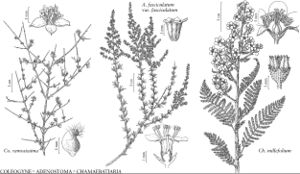Chamaebatiaria
Trudy Imp. S.-Peterburgsk. Bot. Sada 6: 225. 1879.
| Taxon | Illustrator ⠉ | |
|---|---|---|
 | Coleogyne ramosissima Adenostoma fasciculatum var. fasciculatum Chamaebatiaria millefolium | Marjorie C. Leggitt Marjorie C. Leggitt Marjorie C. Leggitt |
Shrubs, erect to widely spreading, 6–20 dm, herbage strongly aromatic. Stems 1–10+, ascending-spreading, strongly branched from base and above; bark russet, with age gray, smooth; long-shoots present; strongly stipitate-glandular, stipitate-stellate, hirtellous, sometimes strongly glutinous. Leaves persistent, cauline, alternate, 1 (–2) -pinnate-pinnatifid; stipules free, subulate to oblanceolate, margins entire; petiole present; blade oblong-ovate, 2.6–7 (–9.6) cm, herbaceous, pinnae 13–25 per side, ascending, opposite to alternate on rachises, narrow, deeply divided into obovate segments, each segment decurrent on rachilla on proximal base, margins entire or secondarily toothed-lobed, surfaces glabrous or stellate-hairy, glandular. Inflorescences terminal on long-shoots of season, 20–400-flowered, panicles narrowly ovoid, lateral branches leafy at bases; bracts present, proximal bracts of reduced leaves, distal bracts lanceolate, pinnate-lacerate, or entire; bracteoles present. Pedicels present. Flowers 10–13 mm diam.; hypanthium funnelform, to 3–4 mm diam.; sepals 5, spreading, ovate-deltate; petals 5, white, orbiculate-reniform, base short-clawed; stamens 70–110 in 2 or 3 series, shorter than petals; carpels (4 or) 5, distinct, appearing connivent at base, sericeous, styles caducous, terminal, slender, stigmas broadened; ovules 10–12 in 2 series. Fruits aggregations of (4–) 5 follicles, each obliquely lanceoloid, 3–5 mm, hirtellous, dehiscent to bases on ventral sutures and halfway along dorsal sutures; hypanthium persistent; sepals persistent, erect to spreading; styles persistent or not. Seeds 3–8, narrowly fusiform, thin walled. x = 9.
Distribution
w United States
Discussion
Species 1.
Vestiture on young stems, inflorescences, leaves, hypanthia, and sepals of Chamaebatiaria is complex, consisting of short, straight or curved, sessile hairs; sessile or thick-stalked stellate clusters of flattened, more or less twisted hairs; and sessile, subsessile, or thick-stalked stipitate glands. In some plants, glands will exude material rendering the stems and leaves glutinous. They may have hairs on the gland tip or on the stalk below the gland.
Molecular data indicate relationships of Chamaebatiaria with the Sorbariaeae, with the Asian Sorbaria and Spiraeanthus (Fischer & C. A. Meyer) Maximowicz, and the North American Adenostoma (D. Potter et al. 2007). The similarity to Chamaebatia is striking. J. A. Wolfe and W. C. Wehr (1988) presented interesting fossil evidence of leaf structure development.
Selected References
None.
Lower Taxa
"thin" is not a number."thin" is not a number."broadened" is not a number.